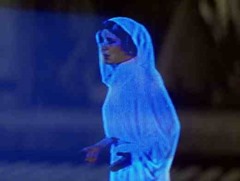The power of 3D interaction
Ok who has ever watched STAR WARS and wanted a 3D princess Leia Hologram?
Holograms are often thought of as an optical novelty that can produce pretty 3D pictures, but they are capable of doing much more than that. One of my colleagues Dr Dave Brown has been continuing to explore natural user interaction with 3D data on a 2D displays specially using Microsoft Windows 8 devices.
As we know user interaction with a user interface can be in 2 or 3 dimensions. Dave work aims to build an orientation-independent user interface for a holographic display, which would naturally lend itself to the type of display being used.
Example of 3D Holographic Experience created for Windows 8
2D interaction is pervasive with the availability of multi-touch enabled displays, and 3D interaction is becoming more accessible with products such as Microsoft's Kinect for Windows and the Leap Motion controller.
For example, a vertical screen behaves as a "virtual window" onto the world such as in a first-person 3D game. A horizontal screen on the other hand, behaves as a "virtual table" for viewing and manipulating objects, or as a view from a third-person game looking "down" onto the world.
|
Princess Leia Hologram |
Viper Hologram |
Raptor Hologram |
Globe Hologram |
All Windows 8 apps now support both landscape and portrait modes. Dave work has been developed to support both horizontal and vertical modes, and since he uses specify orientation using vectors he can also specify any intermediate angle.
For more details on Dr Dave Brown work see https://drdave.co.uk/page/projects
So if you are working on any interesting 3D project we would love to hear more?
